Tejano: Local Music, Global Identity
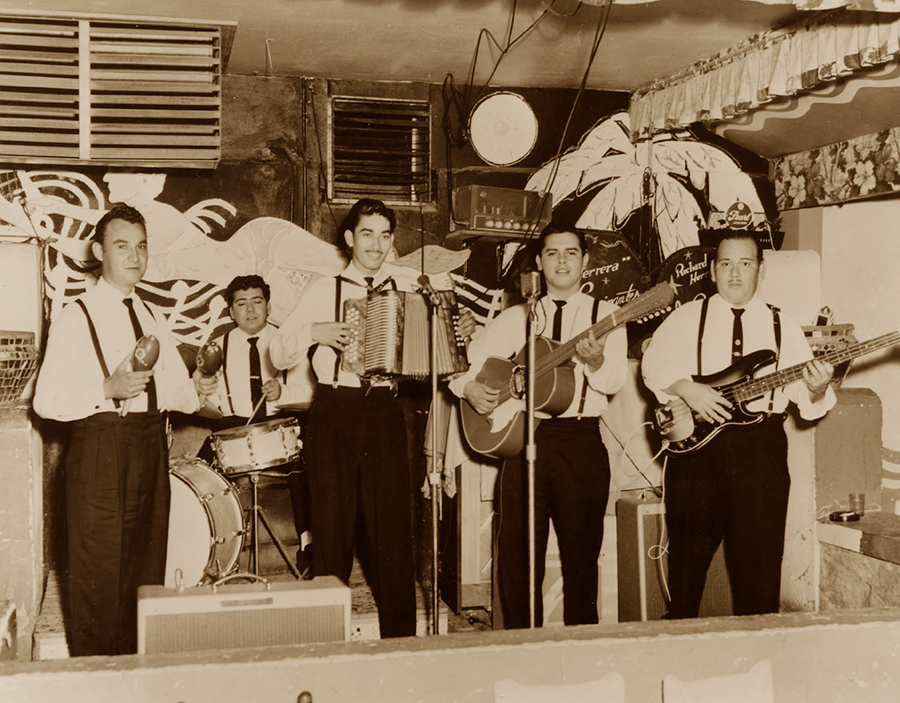
Flaco Jiménez with Los Caminantes (the band he made his first recordings with for Rio Records). San Antonio, mid to late 1950s. Photo courtesy the Arhoolie Foundation, all rights reserved.
Welcome to Texas, birthplace and home of Tejano music.
Tejano in Spanish simply means “Texan.” Tejano music, however, is Texas-Mexican (Tex-Mex) music, which encompasses several musical genres, ensembles, and styles of music, as well as a whole industry that sustains thousands of musicians and workers, independent record labels, a vibrant club and dance scene, radio programs and stations, festivals, and a loyal fan base of local and regional people, with a growing following of national and international music lovers.
Even as embattled as Tejano music has been since its beginnings in the mid-1800s in a racist and segregationist society following the Mexican-American War, and in its position amid a mainstream commercial media in the United States that espouses such things as “English only,” the music has survived and continues to be an important and viable form of creative expression and cultural identity for the Tejano/MeXicano people. And in the case of the conjunto Tejano, has given rise to a truly unique and original American musical ensemble and style of music that ranks with the best and most authentic of jazz, rock, country, Cajun/zydeco, and other ensembles and musical art forms that America has given birth to and shared with the world.
A distinctive Tejano music began developing in the 1820s and 1830s with the unique confluence of peoples and cultures that came together during this time in Tejas: Indigenous, Spanish, Mexican, Anglo/Texan, and US. To understand Tejano music, it is important to know the history of the Tejano people.
Tejanos are primarily Mexicans living in Texas. That means that Tejanos are Mexican/Indigenous people first and foremost. In fact, the word Tejas is an indigenous word from the Hasinai tribes of East Texas that means “friendly” or “allies.” When the Spaniards colonized the “Americas” in the late 1400s and Tejas in the 1600s, they intermixed and married with the indigenous people to create a mestizo people: part Spanish and part American “Indian.” Tejanos are mestizos.
This mestizo population revolted against the oppressive españoles, and Mexico gained its independence from Spain in 1821. Coahuila y Tejas became a northern state of the newly formed nation of Mexico. During this period the Anglos and Europeans from the United States began settling in Texas, and there was a movement by the Texians and Tejanos to secede from Mexico and make Texas an independent republic. This was accomplished at the Battle of San Jacinto in 1836 when Mexican president and general José Antonio López de Santa Anna was captured by the Texian forces and signed over Tejas to Sam Houston. Texas became the twenty-eighth state of the United States of America in 1845, and in 1846 the United States went to war against Mexico, which ended in 1848 with the signing of the Treaty of Guadalupe Hidalgo in which Mexico ceded over half of its northern territory to the United States: New Mexico, Arizona, Nevada, Colorado, California, and parts of Oklahoma, Wyoming, and Utah.
The period after 1848 is important because for the first time in our history a great number of Mexicans were living in the United States, thus beginning the process that created the Chicanos. The term Chicano, which was more popularly used as an ethnic and cultural identifier among the youth during the civil rights movement of the 1960s and 1970s, basically means a Mexican within the United States, albeit with a social, cultural, and political consciousness. The word Chicano comes from the term Mexica, the Nahuatl (Aztec language) name for the Aztecs. Mexicano, pronounced Mechicano (some say Meshicano), is the Nahuatl/Spanish pronunciation for Mexican. Tejanos are Mexicans and Chicanos from Texas.
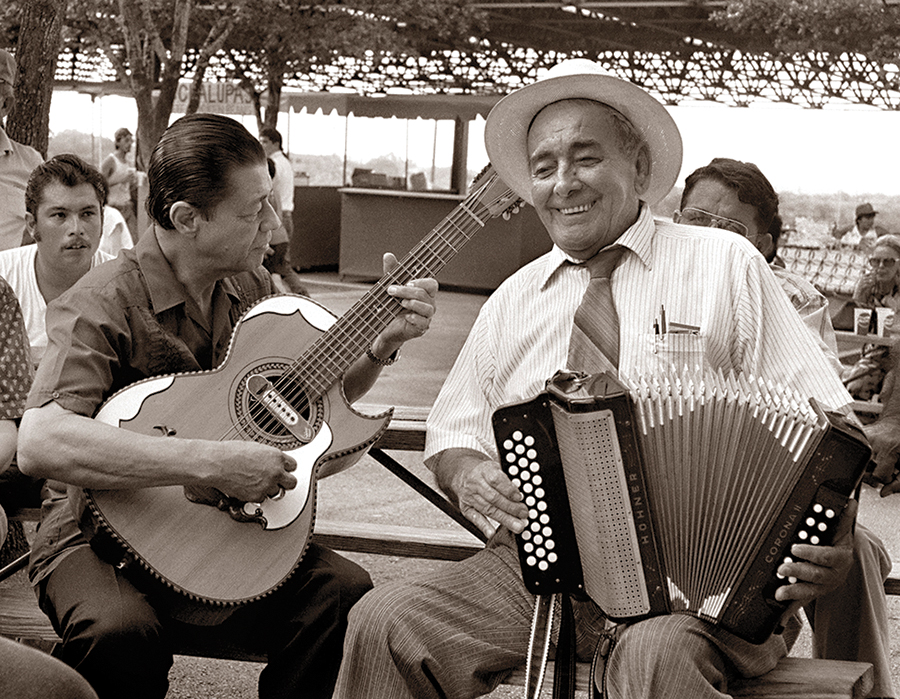
Fred Zimmerle, on left playing the bajo sexto, performing with Narciso Martínez, accordion. Martínez was also known as “El Huracán del Valle” (The Hurricane of the Valley) and is considered the father of Texas-Mexican conjunto. Guadalupe Cultrual Arts Center’s Tejano Conjunto Festival en San Antonio, 1991. Photo Courtesy of Al Rendón.
We make a distinction between Chicanos whose families may have been in the United States for four or five generations, as opposed to those Mexican migrants who have just recently arrived. Chicano culture is different than Mexican, though we have a shared history and culture. For instance, whereas the Mexican’s language is Spanish, within the United States Mexicans have to learn how to speak English, the language of government, laws, and schools. This assimilation and acculturation process that takes place in Chicanos and Tejanos is typical of a “border culture,” Texas/Mexico, Anglo/Mexican, where two or more cultures come into contact and collide, in many ways creating a dialectical process of conflict, resolution, and accommodation — the give and take of peoples learning to live with each other and sharing each other’s culture and space.
This process is key in defining and understanding who we are as a people and all of our cultural and artistic expressions, including our language, literature, food, and music. We are a border culture — Indigenous, Spanish, Mestizo, Mexican, Texan, and American — and all of our cultural expressions are a synthesis of these social, cultural, economic, and political elements that has produced unique and original forms of art, such as Tejano music. Renato Rosaldo calls this process “transculturation,” where “the result is not identity confusion but play that operates within, even as it remakes, a diverse cultural repertoire. Creative processes of transculturation center themselves along literal and figurative borders where the ‘person’ is crisscrossed by multiple identities.” Vicki L. Ruiz calls it “cultural coalescence,” where people “pick, borrow, retain, and creative distinctive cultural forms. There is not a single hermetic Mexican or Mexican-American culture, but rather permeable cultures rooted in generation, gender, and region, class, and personal experience. People navigate across cultural boundaries.” Tejano music crosses these borders and boundaries and is a prime example of “transculturation” and “cultural coalescence,” the whole essentially being different and greater than the sum of its parts.
Manuel Peña, the foremost academic and theoretician of Tejano music and author of three books on the subject, states that “Música tejana is not one single music but several musical and musico-literary genres, ensembles, and their styles. It encompasses the major musico-literary genres covered in this book [Música Tejana] — the corrido, canción, and what I call the canción-corrido. It also includes two major regional ensembles and their styles — the conjunto, a close cousin of música norteña [music of Northern Mexico], and the Texas-Mexican version of the orquesta, a multi-styled wind [and brass] ensemble patterned after the American swing band. Lastly, música tejana also includes yet another, more recent crop of synthesizer-driven ensembles and their styles, known since the mid-1980s as ‘Tejano.’” To this I would add a number of hybrid ensembles that combine distinctive instrumentation and styles of music, such as the progressive conjunto Tejano ensemble that might combine the button accordion with synthesizer and a couple of saxophones, and a Tejano country ensemble that utilizes a steel guitar and fiddle with a button accordion and a bajo sexto (twelve-string bass rhythm guitar).
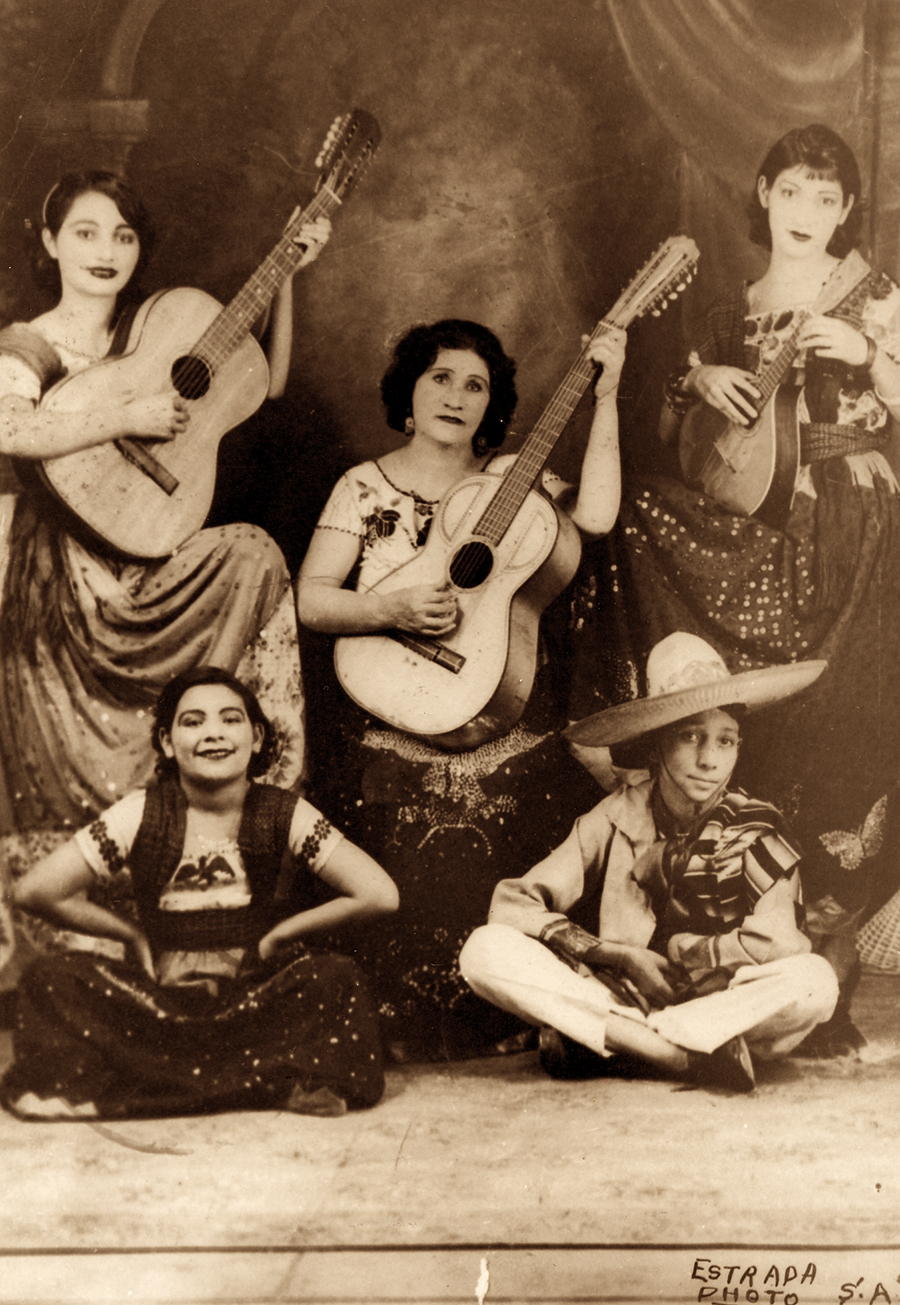
La Familia Mendoza: Lydia, Juanita, Leonor, Manuel, y Maria. In 1982, Lydia, known as “La Alondra de la Frontera” (the Lark of the Border), became the first Texan to receive the National Heritage Fellowship lifetime achievement award from the National Endowment for the Arts. In 1999, she was awarded the National Medal of Arts. And in 2003, she was part of the second group of recipients to be awarded the Texas Medal of Arts by the Texas Cultural Trust. Photo courtesy the Arhoolie Foundation, all rights reserved.
Tejano music is dance music. You cannot separate one from the other. In his book Música Tejana, Peña gives a class-based analysis of the history and sociocultural development of Tejano music and dance. In the mid-1800s, working-class Mexicans living in a primarily rural Tejas had their vocal music genres, canciones (lyrical songs) and corridos (ballads), which were sung in Spanish by a lone individual on the guitar, or maybe as a duet, or with a small string or wind ensemble. Tejano musicians sung these canciones and corridos and played their dance music at weddings and bautismos, family and cultural celebrations, and fandangos (dances) out in the country. There was still an elite of Spanish/Mexican landowners who could afford large ensembles and orchestras for their daughters’ quinceañeras and bailes (more elite dances), but most of the people were poor and lived off the land. The canciones and corridos told the stories of the Mexicano/Tejano people — their lives on the rancho, their hardships, and their loves.
The corrido, a sung ballad of the Texas/Mexican border that dates back to the 1830s, is one of the earliest original forms of Tejano music and literature and has been well documented by the great Mexican American scholar Américo Paredes in his book With His Pistol in His Hand: A Border Ballad and Its Hero. As Peña states, “the corrido of the nineteenth century responded far more vigorously than the contemporaneous canción to the intercultural encounter and its conflict — particularly the subtype Paredes has labeled the ‘corrido of intercultural conflict.’” Peña continues: “The corrido of intercultural conflict thus emerged as the most symbolically effective artistic expression forged by the tejanos in their struggle to negotiate both economic upheaval and conflict with the aggressive Anglos.” In the “Corrido de Gregorio Cortez,” Cortez kills the Anglo sheriff who had shot his brother, then flees and is pursued by the Texas Rangers. The corrido narrates the story, usually in waltz or polka form, of how Cortez defended his brother “with his pistol in his hand” and outwitted the Texas Rangers through his intelligence and exceptional horsemanship. In the process, Cortez becomes a hero to the exploited and downtrodden Mexicano people living on the border under Anglo control. The corrido is an important communication vehicle and form of historical documentation for the Mexicano/Tejano people, and individuals and bands continue to compose and perform them to this day.
The canción-corrido that Peña mentions is a musical and literary adaptation of the more rigid corrido musical form. It still narrates a story but may have other musical elements, for instance, a chorus, that the traditional corrido would not.
The conjunto is the original Tejano/American musical ensemble and style of music created on the Texas/Mexico border. The Spanish word conjunto means “ensemble” or “group.” For Tejanos, however, it has come to mean a specific type of musical group that uses the accordion as its main instrument. German and other European settlers introduced the button accordion to Texas and Mexico during the mid-to-late 1800s, and the Mexicans living there adopted this squeeze-box instrument, which was based on the harmonica. It was relatively cheap and easy to play, and it quickly became a favorite musical instrument at fiestas and family celebrations among the Mexican people. The polka rhythm and salon dance music were sweeping the world at this time, and the Mexicanos loved dancing to the accordion’s harmonious instrumental melodies and fast-paced polka, as well as the beautiful waltzes, schottisches, and redovas. When the accordion was paired up with the bajo sexto during the early 1900s, this new ensemble and style became known as conjunto.
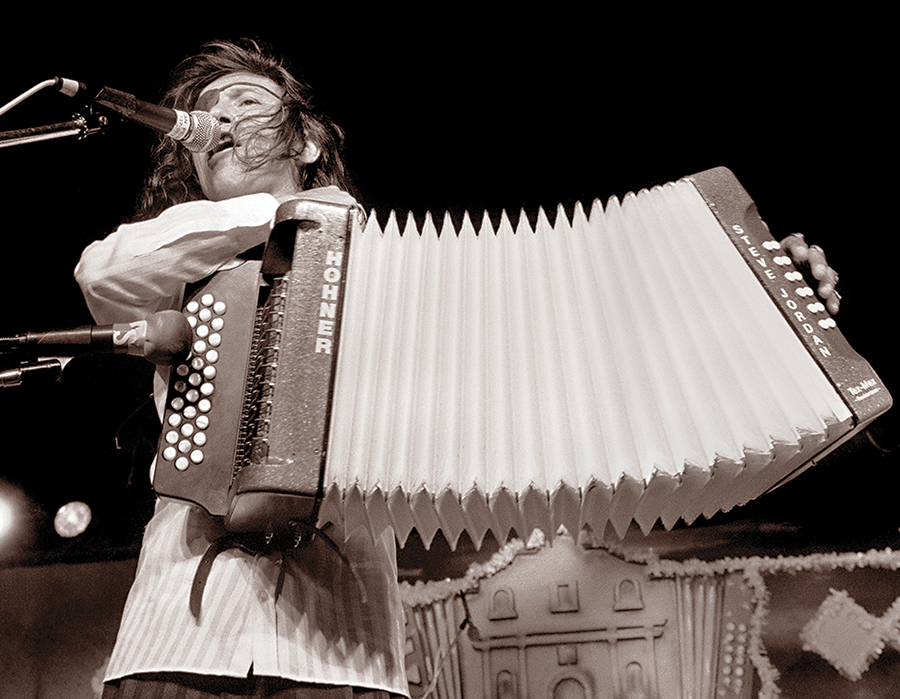
Esteban Jordán, known as “El Parche,” has also been referred to as the Jimi Hendrix of the accordion for his innovations on the instrument. Guadalupe Cultural Arts Center’s Tejano Conjunto Festival en San Antonio, 1990. Photo Courtesy of Al Rendón.
The early “ethnic” recordings by major labels in the 1920s and 1930s, participated in by many Tejano musicians such as Bruno Villarreal, Lolo Cavazos, Lydia Mendoza, and Narciso Martínez, helped to firmly embed and establish the emerging conjunto ensemble as the preferred musical group at most Mexican/Tejano working-class celebrations and dances. As the conjunto ensemble and style evolved, the tololoche (stand-up acoustic bass) was added; then after World War II, with the advent of amplification, the final two instruments to the standard, traditional four-piece conjunto ensemble were added: the electric bass and trap drum set.
From the 1930s to the 1960s, other musical styles and rhythms were integrated into the standard conjunto Tejano repertoire, such as the indigenous/Mexican huapango, from the Huasteca region in Mexico; the Cuban bolero; the Columbian cumbia; and even some blues, rock ‘n’ roll, country, and jazz. Stylistic innovators in the genre included Santiago Jiménez Sr. and Narciso Martínez, “El Huracán del Valle” (Hurricane of the Valley), two of the “fathers” of conjunto music; and Valerio Longoria, Tony De la Rosa, Rubén Vela, Conjunto Bernal, Esteban Jordán, and Flaco Jiménez.
The next important ensemble and style of Tejano music is the orquesta Tejana. A scaled-down version of the American big bands and Mexican orchestras of the 1920s with their large woodwind and brass sections, the orquesta Tejana came into prominence after World War II as Mexican Americans moved from the ranches to the cities and gained some degree of social mobility as more of them entered the middle class. Many of these Mexican Americans aspired toward assimilation into American life, so the “classier” orchestra music better expressed their lifestyle. Peña states that “the uniqueness of the orquesta lies in its stylistic invention — inventions that stamped a powerful bimusical identity on the ensemble. As we shall see, this identity mirrored, at the level of musical expression, the ideological structures underpinning the bicultural identity of the middle-class Texas-Mexicans who forged the orquesta tejana.”
The musical repertoire of the orquesta was initially American big band jazz and popular music, with some Mexican/Latino tropical music such as boleros and mambos. However, Beto Villa, who is considered the “father” of the orquesta Tejana, began performing polkas and polkas rancheras (songs sung in Spanish to a polka beat) and waltzes, which were more of the working-class domain of the conjunto, with his orquesta and horn arrangements. This was the beginning of the distinctive sound of the Texas-Mexican, or Tejano, orquesta. During the 1950s and 1960s, bands like Little Joe & the Latinaires and Sunny and the Sunglows performed the popular rhythm and blues and early rock ‘n’ roll of the times, and every now and then threw in a cumbia, a bolero, or a polka ranchera sung with Spanish lyrics. Little by little the repertoire shifted to a more dominant Tejano song list.
The heyday of the orquesta Tejana came during the late 1960s and 1970s in what is known as the Chicano movement period of the civil rights era in the United States. During this time Tejano music became known as La Onda Chicana. Orquestas Tejanas proliferated throughout Texas and other parts of the United States, including such popular bands as the Royal Jesters, Latin Breed, Tortilla Factory, Ruben Ramos and the Mexican Revolution, and the renamed Sunny and the Sunliners and Little Joe y La Familia. It was during this period that the orquesta Tejana created what Peña calls a “’compound’ form of bimusicality — where styles identifiable as Mexican ranchero and those identifiable as sophisticated American swing-jazz were yoked together within the same musical piece to create, in effect, a hybrid or synthetic music.”
The 1970s and 1980s saw the development of the popular keyboard and synthesizer-driven Tejano bands, such as La Mafia from Houston, Mazz from the Rio Grande valley, and Selena y Los Dinos from Corpus Christi. Traditional accordion-based conjuntos continued to develop alongside the orquestas Tejanas, and then there was a third fusion of those bands that combined all three instrumental elements in different configurations: accordion, horns, keyboard/synthesizers, percussion, and so on. People like the great vocalists Chacha Jiménez with Los Chachos and Laura Canales y Los Fabulosos Cuatro were early influences. Bene Layton y Los Layton and Roberto Pulido y Los Clásicos created classic combinations of the button accordion and saxophone ensembles that paved the way for such fusion bands as David Lee Garza y Los Musicales, Jay Pérez, and Emilio Navaira and Río.
These top Tejano bands road the pinnacle of the Tejano explosion of the late 1980s and early 1990s that witnessed the major recording labels like Sony, Capitol EMI, and Warner Bros. entering the Tejano market because they saw a potentially huge market in the growing number of Hispanics in the United States, as well as the rest of Latin America and the Spanish-speaking world. That was the apex of Tejano music. In San Antonio, for instance, there were about nine Tejano, bilingual, or Spanish-language radio stations, and we had about four or five huge Tejano clubs that sat three to four thousand people. Conjuntos and other Tejano bands were playing at smaller clubs all over the city. The major record labels made a little money initially but apparently not enough for them to stay in the market. By the time Selena was tragically murdered in 1995, almost all of the major labels were pulling out of the Tejano market, and thus began a slow decline, at least in terms of “commercial” success, as Tejano music moved into the twenty-first century.
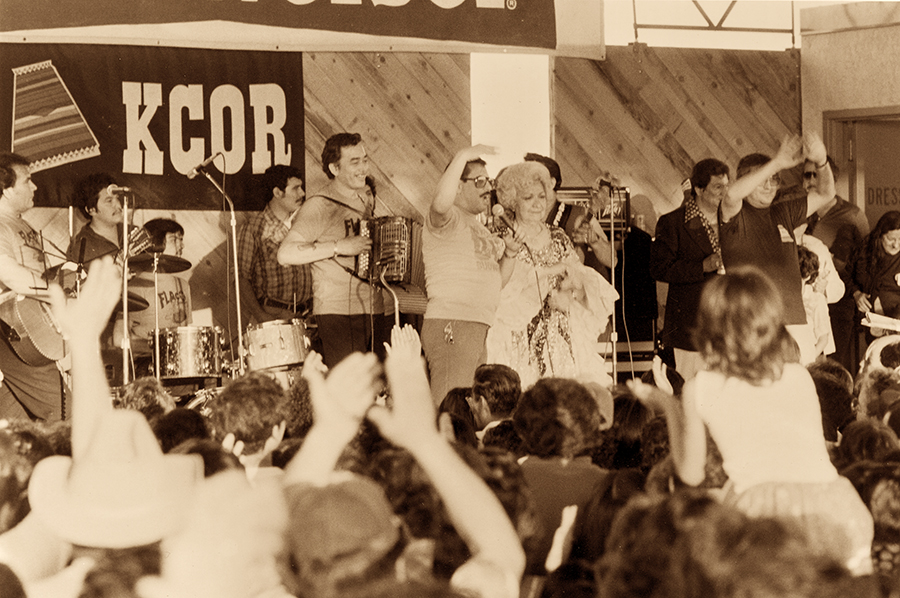
Chelo Silva backed by Flaco Jiménez, San Antonio Texas, 1983. Photo courtesy the Arhoolie Foundation. © Chris Strachwitz, all rights reserved.
Success, however, is defined in many ways. While the commercial Tejano recording, radio, and club/promotions industry has waned over the past two decades as it has been consolidated into Tejano hands, the music side of the genre has not only survived but thrived. Never before in the history of Tejano music have there been more youth taking accordion and bajo sexto lessons at community-based conjunto programs around the state, including a few high school programs in the valley. There are numerous Chicano/Latino cultural arts centers, festivals, and awards programs in the nation, and the Tejano Music Awards and the Tejano Conjunto Festival en San Antonio celebrated their thirty-fourth and thirty-third year anniversaries, respectively, in 2014. More independent Tejano recording companies and radio programs are producing music and using the Internet and social media to promote it. But more importantly, people are creating and performing Tejano music, and it is very much alive and a part of Tejano/Chicana/o celebrations of familia and cultural identity. And on any given weekend you can hear conjuntos, orquestas, and other Tejano bands performing in city bars and barrio cantinas, where la raza dance “el tacuachito” (little opossum style of original Tejano polka dancing) and take a twirl or two to a cumbia beat while dancing counterclockwise in a circle and magically suspending time, if only for a moment.
Tejano music is all of this and more. It is local music with a global identity. It is world music that is a unique synthesis of the German/European button accordion with its polkas and waltzes, combined with the Spanish bajo sexto guitar and indigenous/Mexican rhythms such as the huapango. It is Chicano music that fuses African American blues, rhythm and blues, rock, and jazz with Mexican ranchero songs sung primarily in Spanish, though increasingly with English and bilingual lyrics. Tejano music is the adapted Columbian cumbia and Cuban bolero and the Texas twang of Tejano country. It is salsa, merengue, and reggae from the Afro-Latino Caribbean influence, combined with bilingual rap to produce reggaeton, and the early orquesta Tejana rap-cumbia “Las Hijas de Don Simón” by Tierra Tejana from Seguín, Texas. It is the jazz-polka ranchera fusion of the classic “Las Nubes” by Little Joe y La Familia, the Spanish translated conjunto country version of Johnny Cash’s “Folsom Prison Blues,” “La Última Milla” (The Last Mile), with button accordion and harmonica by Mingo Saldívar y sus Tremendos Cuatro Espadas. And it is the reggae-cumbia version of Selena’s “Bidi Bidi Bom Bom,” and the Tejano reggaeton bilingual cumbia rap of the Kumbia Kings.
Tejano music still has its canciones and corridos and the traditional conjuntos and orquestas Tejanas, as well as all of the other synthesizer and hybrid bands mentioned above. The next generation of Tejano musicians are preserving and continuing to perform the musical styles begun by their fathers, some of the innovative giants in the genre, such as Los Conjunto Kings de Flavio Longoria (son of Valerio Longoria), Rio Jordán (Steve and Richard Jordán, sons of Esteban Jordán), Rubén Vela Jr. y su Conjunto, and Ricky Naranjo y Los Gamblers, fronted by accordionist Rubén Naranjo III (son and grandson of Rubén Naranjo). To this list we can add Bobby Pulido and David Lee Garza y Los Musicales, among many others.
At the same time, young, experimental individuals and bands are pushing the limits of the Tejano musical traditions: Nina Díaz from Girl in a Coma, the conjunto punk music of Piñata Protest, the reggae/ranchera/huapango/blues/jazz poetic stylings of Los Nahuatlatos, the bilingual cumbia/reggae/rap of Bombasta Barrio Big Band, and the conjunto/country/rockabilly music of Nick Gaitán and the Umbrella Man. And check out the smooth conjunto blues/jazz of blind button-accordion prodigy Juanito Castillo (you can download on iTunes his remake of Chet Baker’s “I Fall in Love Too Easily,” and Los Nahuatlatos’ “My Main Squeeze,” recorded live at the thirty-second annual Tejano Conjunto Festival in San Antonio in 2013).
Beleaguered as we have been by a racist, exploitive, segregationist, and at the same time homogenizing, colonizing Spanish and US society, culture, educational system, and media, Xicanas/os have resisted, accommodated, and survived, celebrating our “otherness” and multicultural diversity in the process. Tejano music is an excellent example of “Chicano/Tejano cultural citizenship.” William V. Flores, in the book Latino Cultural Citizenship: Claiming Identity, Space, and Rights, states that “cultural citizenship can be thought of as a broad range of activities of everyday life through which Latinos and other groups claim space in society, define their communities, and claim rights. It involves the right to retain difference, while also attaining membership in society. It also involves self-definition, affirmation, and empowerment.”
In many ways, our Saturday night Tejano dances are our church and our spirituality. They are our sacred spaces where we come together to celebrate and commune con la raza (the people) and la familia, hear some music, maybe have a cervezita or two, talk with each other, and support and affirm our cultural identity as we dance the night away before we prepare for the school and work week ahead.
As I look around, I feel positive about the future of our people and Tejano music.
I do not quite remember when I first heard or read about the concept of La Raza Cósmica. I think I read it in a poem by alurista or Ricardo Sánchez. Or maybe I heard it in a song when I was a student at the University of Texas in Austin during the early 1970s. The Chicano civil rights movement and cultural renaissance were in full bloom then, and it was the beginning of my social and political consciousness. I came to realize that I was one of these “cosmic people.” That within my indigenous and Spanish blood was united all of the races of this known world: black and white from my español side, yellow and red from my indigenous side. Tejano music is a cosmic American original. It is a powerful multicultural musical and artistic expression of the MeXicana/o people, and we offer it to humanity and to all our relations in the spirit of unity, respect, justice, peace, and love. And the Creator knows that we need some peace and love in this world right now, ¿que no? ¡Ahora sí, a bailar!
In lak’ ech / Tu eres mi otro yo / You are my other self. (Mayan phrase)
